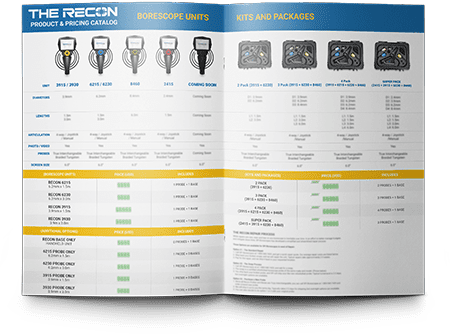The inspection process of an aircraft is vital to maintaining the right performance and operation standards of any and all aircrafts. Without a proper inspection, an aircraft is likely to run with undiagnosed issues that will end up affecting the overall operation of the individual components and systems. In time, the aircraft will breakdown. This is why many commercial aircraft inspectors rely heavily on inspection tools like aviation borescopes.
Types of Aircrafts Inspection with an Aviation Borescope
If you have traveled by commercial airplane in the last ten years, you’ve flown on an aircraft that was inspected by a professional grade articulating borescope. Some of the few (of many) examples of specific types of these aircrafts and their engines include:
Narrow body aircrafts
Examples include those such as B737 or A320 family
Engines inspected include: CFM56 series, V2500, RB211-535, RR Tay, JT8D, PW2000
Wide body aircraft
Examples include aircrafts such as the B767, B747, A340, DC10 and Tristar
Engines inspected include: CF6 series, CFM56-5C, RR Trent, 500, 700, 800, 1000, RB211-525, 22B, PW4000 series, JT9D
Turboprop aircraft
Examples include aircrafts such as the Beechcraft Kingair, Cessna Caravan, Pilatus PC12, ATR 42, and 72
Engines inspected include: PT6A series and PW100 series
The Important of Commercial Aircraft Inspection
Inspection using an aviation borescope will help to greatly extend the life of an aircraft. During the inspection process, mechanics are able to visually inspect vital internal and external parts and systems to make sure everything is running as it should. By catching issues ahead of time, it can prevent dangerous failures and downtime for the operation of the aircraft.
For commercial aircraft, inspection is not just important, it’s a required part of regular use. Commercial aircraft have an obligation to the safety of many passengers, not just the pilot and/or owner of the aircraft, as is the case with privately owned aircraft.
Aircraft Equipment That Requires Inspection
There are certain interval requirements for inspection which will typically include requiring an inspection after a certain amount of hours, time, and even a checklist before and after each flight. These inspections will cover the whole of the commercial aircraft, but some parts need more attention than others. Specific equipment inspection is performed on parts known to be under the greatest stresses, or have the most impact on the rest of the system. A lot of the time, these kinds of part-specific inspections are performed on or around the engine or turbine. The power plant of an aircraft takes a lot of abuse, but the aircraft need these systems to run at top performance in order to keep the plane up in the air.
Specific part and system inspection include the lubrication system, cooling system, fan blades, and other components that have to run perfectly in order to keep the entire engine operating as it should. Identifying issues at the points can make for a quick and easier replacement or repair, and sometimes just a simple draining and replacement of fluids, to make sure there’s no further damage. They can also tip-off to other areas that need to be inspected from possible damage.
There are many good reasons that commercial aircraft owners and mechanics use aviation borescopes to maintain their equipment. Using these tools can help operators get an eye on important components in a hurry, and without teardown. When there’s so much at stake, there’s only time to use the best!
Related Articles
Learn more about aviation borescopes and their real-world applications
Aviation Body & Engine
Aviation maintenance is a large and crucial part of the aviation industry as aircraft and engines are in constant need of inspection, preventative maintenance, and repair in order to keep these flying machines, running, effective and safe….
Most common aircraft turbine problems are avoidable with the use of an aviation borescopes to detect problems before they become disasters!
An aviation borescope is an invaluable piece of inspection equipment that any professional aircraft owner and mechanic need to have in their toolbox. Using one of these high-tech inspection tools can help….
How is An Aviation Borescope Used in a 100-Hr Inspection?
In the aviation industry, the use of borescopes is common as this is an invaluable inspection tool, and inspections are not only needed, they are required for most aircraft. Because of this, having a high-quality and reliable aviation borescope is a must for any professional ….
6 Warning Signs to Look for When Performing an Aviation Borescope Inspection on an Aircraft Engine
Aviation borescope inspection is an important practice on any aircraft. Inspection requirements vary by craft type, and usage. For example, commercial and military aircraft are required ….
3 Types of Rocket Engines Used for Space Travel that Undergo Aviation Borescope Inspections
Space travel almost seems like its routed in pure magic, but a ton of engineering and highly advanced parts go into to make this ‘magic’ actually possible. Whether it’s manned or unmanned space crafts ….
Why a Military Aircraft Needs More Aviation Borescope Inspections Than Commercial Aircrafts
In the United States Military, there are currently over 13,000 aircraft in service to help protect our country. These include everything from transport aircraft, fighter aircraft, trainer aircraft, and so much more….
Related Articles
Learn more about aviation borescopes and their real-world applications
Aviation Body & Engine
Aviation maintenance is a large and crucial part of the aviation industry as aircraft and engines are in constant need of inspection, preventative maintenance, and repair in order to keep these flying machines, running, effective and safe….
Most common aircraft turbine problems are avoidable with the use of an aviation borescopes to detect problems before they become disasters!
An aviation borescope is an invaluable piece of inspection equipment that any professional aircraft owner and mechanic need to have in their toolbox. Using one of these high-tech inspection tools can help….
How is An Aviation Borescope Used in a 100-Hr Inspection?
In the aviation industry, the use of borescopes is common as this is an invaluable inspection tool, and inspections are not only needed, they are required for most aircraft. Because of this, having a high-quality and reliable aviation borescope is a must for any professional ….
6 Warning Signs to Look for When Performing an Aviation Borescope Inspection on an Aircraft Engine
Aviation borescope inspection is an important practice on any aircraft. Inspection requirements vary by craft type, and usage. For example, commercial and military aircraft are required ….
3 Types of Rocket Engines Used for Space Travel that Undergo Aviation Borescope Inspections
Space travel almost seems like its routed in pure magic, but a ton of engineering and highly advanced parts go into to make this ‘magic’ actually possible. Whether it’s manned or unmanned space crafts ….
Why a Military Aircraft Needs More Aviation Borescope Inspections Than Commercial Aircrafts
In the United States Military, there are currently over 13,000 aircraft in service to help protect our country. These include everything from transport aircraft, fighter aircraft, trainer aircraft, and so much more….
Commercial Airplane Wing Inspection
Airplanes involve many different parts working together to make certain it operates smoothly. Commercial airplane wings are particularly….
Landing Gear Inspections
A commercial aircraft’s landing gear consists of large, main wheels situated at the middle of the plane near the wings. There is….


